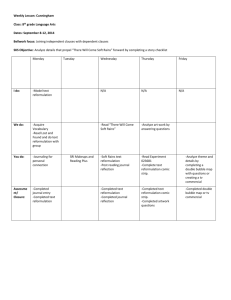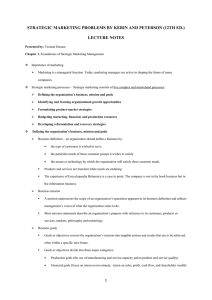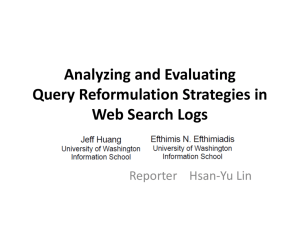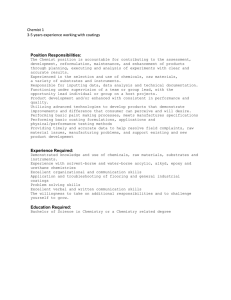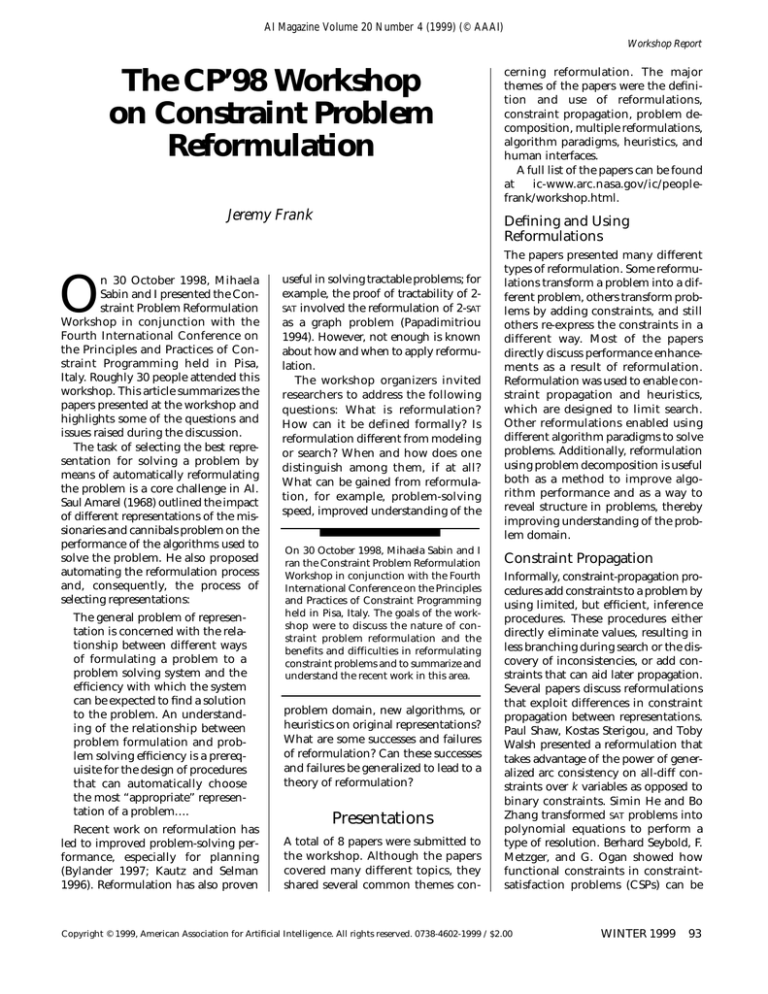
AI Magazine Volume 20 Number 4 (1999) (© AAAI)
Workshop Report
The CP’98 Workshop
on Constraint Problem
Reformulation
Jeremy Frank
O
n 30 October 1998, Mihaela
Sabin and I presented the Constraint Problem Reformulation
Workshop in conjunction with the
Fourth International Conference on
the Principles and Practices of Constraint Programming held in Pisa,
Italy. Roughly 30 people attended this
workshop. This article summarizes the
papers presented at the workshop and
highlights some of the questions and
issues raised during the discussion.
The task of selecting the best representation for solving a problem by
means of automatically reformulating
the problem is a core challenge in AI.
Saul Amarel (1968) outlined the impact
of different representations of the missionaries and cannibals problem on the
performance of the algorithms used to
solve the problem. He also proposed
automating the reformulation process
and, consequently, the process of
selecting representations:
The general problem of representation is concerned with the relationship between different ways
of formulating a problem to a
problem solving system and the
efficiency with which the system
can be expected to find a solution
to the problem. An understanding of the relationship between
problem formulation and problem solving efficiency is a prerequisite for the design of procedures
that can automatically choose
the most “appropriate” representation of a problem….
Recent work on reformulation has
led to improved problem-solving performance, especially for planning
(Bylander 1997; Kautz and Selman
1996). Reformulation has also proven
cerning reformulation. The major
themes of the papers were the definition and use of reformulations,
constraint propagation, problem decomposition, multiple reformulations,
algorithm paradigms, heuristics, and
human interfaces.
A full list of the papers can be found
at
ic-www.arc.nasa.gov/ic/peoplefrank/workshop.html.
Defining and Using
Reformulations
useful in solving tractable problems; for
example, the proof of tractability of 2SAT involved the reformulation of 2-SAT
as a graph problem (Papadimitriou
1994). However, not enough is known
about how and when to apply reformulation.
The workshop organizers invited
researchers to address the following
questions: What is reformulation?
How can it be defined formally? Is
reformulation different from modeling
or search? When and how does one
distinguish among them, if at all?
What can be gained from reformulation, for example, problem-solving
speed, improved understanding of the
On 30 October 1998, Mihaela Sabin and I
ran the Constraint Problem Reformulation
Workshop in conjunction with the Fourth
International Conference on the Principles
and Practices of Constraint Programming
held in Pisa, Italy. The goals of the workshop were to discuss the nature of constraint problem reformulation and the
benefits and difficulties in reformulating
constraint problems and to summarize and
understand the recent work in this area.
problem domain, new algorithms, or
heuristics on original representations?
What are some successes and failures
of reformulation? Can these successes
and failures be generalized to lead to a
theory of reformulation?
Presentations
A total of 8 papers were submitted to
the workshop. Although the papers
covered many different topics, they
shared several common themes con-
The papers presented many different
types of reformulation. Some reformulations transform a problem into a different problem, others transform problems by adding constraints, and still
others re-express the constraints in a
different way. Most of the papers
directly discuss performance enhancements as a result of reformulation.
Reformulation was used to enable constraint propagation and heuristics,
which are designed to limit search.
Other reformulations enabled using
different algorithm paradigms to solve
problems. Additionally, reformulation
using problem decomposition is useful
both as a method to improve algorithm performance and as a way to
reveal structure in problems, thereby
improving understanding of the problem domain.
Constraint Propagation
Informally, constraint-propagation procedures add constraints to a problem by
using limited, but efficient, inference
procedures. These procedures either
directly eliminate values, resulting in
less branching during search or the discovery of inconsistencies, or add constraints that can aid later propagation.
Several papers discuss reformulations
that exploit differences in constraint
propagation between representations.
Paul Shaw, Kostas Sterigou, and Toby
Walsh presented a reformulation that
takes advantage of the power of generalized arc consistency on all-diff constraints over k variables as opposed to
binary constraints. Simin He and Bo
Zhang transformed SAT problems into
polynomial equations to perform a
type of resolution. Berhard Seybold, F.
Metzger, and G. Ogan showed how
functional constraints in constraintsatisfaction problems (CSPs) can be
Copyright © 1999, American Association for Artificial Intelligence. All rights reserved. 0738-4602-1999 / $2.00
WINTER 1999
93
Workshop Report
propagated effectively using path consistency, leading to the elimination of
redundant constraints. Henry Kautz
and Bart Selman showed how certain
types of constraint propagation can be
done in SAT encodings of STRIPS planning
problems. Berthe Choueiry and Guevara Noubir discussed how to remove
constraints among given variables to
partition their domains into equivalence classes, which can be used in a
new adaptive strategy for hierarchical
arc consistency.
Heuristics
Reformulation can lead to either
heuristics or bounds that can also be
used to limit search. For example,
Alexander Bockmayr and Yannis
Dimopolous used linear programming
approximations to bound plan length
in planning problems by allowing variables representing plan steps beyond a
certain point to have noninteger values. The solution to the resulting
mixed integer–linear programming
problem provides a bound on the quality of the plan.
Algorithm Paradigms
Reformulation can take advantage of
different algorithm paradigms that are
more effective in some domains. Kautz
and Selman reformulated planning
problems to take advantage of backtracking and local search to solve
propositional representations of planning problems. Bockmayr and Dimopolous also reformulated planning
problems to take advantage of linear
programming; in conjunction with
problem decomposition, they were
able to find bounds on solutions to
planning problems to prune search
more effectively.
Problem Decomposition
Problem decomposition involves
dividing problems into subproblems
that can be solved separately, leading
to both increased performance as a
result of problem-size reduction and
implicit parallelism. Choueiry and
Noubir discussed a reformulation that
effectively generates a conjunctive
decomposition of a CSP into two independent subproblems, thus reducing
the overall computational complexity
of solving the original problem yet
94
AI MAGAZINE
guaranteeing, under well-specified
conditions, the preservation of satisfiability. Seybold, Metzger, and Ogan
showed that certain CSPs can be divided into functional and nonfunctional
subproblems; the efficient handling of
functional CSPs resulted in a decomposition of the problem variables that
lead to better problem-solving performance for these CSPs. Sabin and
Eugene Freuder showed how certain
representations implicitly decompose
problems into subproblems and discuss the pitfalls of these representations. These pitfalls include unnecessary constraints and unintended
inconsistencies. Jean-Louis Bouquard
and Christian Lenté decomposed a
problem with a single resource by solving an equivalent problem on multiple
resources, thereby improving problemsolving performance.
Multiple Reformulations
Several reformulations are sometimes
even more effective than a single reformulation. Kautz and Selman used multiple reformulations to solve planning
problems, first by fixing plan length to
produce a GRAPHPLAN representation,
then by translating into SAT representation. This procedure allowed constraint
propagation in both domains to effectively reduce the complexity of the
resulting SAT representation even more.
Human Interfaces
Some reformulations are designed to
improve the ability of humans to interact with automated problem solvers.
Bouquard and Lenté indicated that
representing sequence-dependent setup cost in scheduling is not possible
using constraints in standard constraint solvers; reformulation allows
them to encode the problem easily in
these constraint-solver packages. Shaw,
Sterigou, and Walsh showed that representing a problem with k-ary constraints results in a shorter and more
intuitive description than representing
the same problem with binary constraints. Symmetries and interchangeability are also useful for supporting
interaction with users by summarizing
families of partial solutions that are
qualitatively equivalent. Choueiry and
Noubir discussed the approximation of
the interchangeability relations among
the values of a CSP variable, allowing
families of solutions to be found efficiently and summarized easily.
Issues
The workshop presentations stimulated considerable discussion. This discussion revealed that there is still considerable room for improvement in
understanding reformulation. The following subsections present the current
state of knowledge concerning reformulation.
What Is Reformulation?
Although a formal definition of reformulation remains elusive, there are
several intuitive notions of what distinguishes reformulation from other
techniques. In contrast to abstraction
and approximation, reformulation is
intended to modify the formulation of
a problem yet keep the essence of the
problem unchanged. Although solutions might be lost or added in abstraction, reformulation only transforms
the solution space. The reformulated
problem necessarily belongs to the
same complexity class as the original
problem. However, the reformulation
can take advantage of algorithms with
improved average-case complexity.
Reformulation is similar to modeling, that is, the task of formally stating
a problem in a rigorous, mathematical
way. However, reformulation is also
related to the problem-solving process
itself. These concepts occupy a continuum, with modeling at one end,
search and problem solving on the
other end, and reformulation in the
middle. What distinguishes reformulation from modeling and reformulation
from search and problem solving?
There are ways to distinguish modeling from reformulation. One perspective is that the modeling effort ceases
when the problem is represented formally. Reformulation, then, is the
translation of one formal representation of a problem into a different formal representation of the same problem, subject to the constraints
mentioned in the previous paragraph.
Reformulation is useful because modeling is difficult, and it is often easier to
manipulate a formal model than it is
to redo the modeling effort. For exam-
Workshop Report
Announcement
NASA Ames Research Center
Conference on Information Technology
For SBIR and STTR Programs
he Information Systems Directorate at the NASA Ames Research Center wishes to increase the participation of the small business
community in the Small Business Innovation Research (SBIR) Program and the Small Business Technology Transfer (STTR) Program. Consequently, NASA Ames Research Center is convening a conference on January 20, 2000 to acquaint the small business
community with ongoing activities at Ames in the areas of information technology that would be most fruitful for small business participation through the SBIR and STTR Programs. In addition to the formal presentation on January 20, Ames will be offering a training
course on January 19, for writing successful SBIR and STTR Phase I and Phase II proposals.
DATE:
January 19 and 20, 2000
PLACE:
NASA Ames Conference Center, Moffett Field, CA
T
Wednesday Training:
"Writing Successful Phase I and Phase II SBIR and STTR Proposals" by Gail and Jim Greenwood
Attendance will be limited to the first 75 applicants
Thursday Presentation:
1. Data Systems Health and Safety
2. Neural Networks
3. Automated Reasoning for Autonomous Systems
4. Tele-operations and Virtual Environments
5. Advanced Concepts in Air-Traffic Management
6. Phase III Success by Accurate Automation
7. Phase III Success by QualTech
RSVP:
Contact: Loretta Goolsby • Phone: 650-604-5063 • FAX: 650-604-6990 • E-Mail: lgoolsby@mail.arc.nasa.gov
ple, the original model might contain
excessive representational power, and
the reformulation might involve eliminating the excess power. Automated
reformulation requires an initial representation and target representations
encoded in software; thus, modeling is
the step that occurs before automated
reformulation is possible.
It is more difficult to distinguish
reformulation from problem solving
and search. One can argue that search
is merely a sequence of reformulations,
with the last reformulation exposing
the solution. Herbert Simon (1969)
wrote that
all mathematics exhibits in its
conclusions only what is already
implicit in its premises…. Hence
all mathematical derivation can
be viewed simply as change in
representation, making evident
what was previously true but
obscure.
This view can be extended to
problem solving—solving a prob-
lem simply means representing it
so as to make the solution transparent.
Intuitively, however, reformulation is
different from an elementary search
step; refining this intuition is the subject of future research.
The Uses of Reformulation
The workshop presentations showed
that reformulation has many uses. For
example, a number of different reformulations were shown to improve
problem solver performance in terms
of speed of solvers or memory use.
Reformulation can also improve the
human interface to problem solvers.
Choueiry and Noubir demonstrated a
reformulation that enables compact
representation of families of solutions
and showed how these solutions
behave when additional constraints are
imposed on the problem instance.
Three papers used reformulation to
promote software reuse: First, the reformulation by Bouquard and Lenté per-
mitted the use of a standard constraint
in a commercial constraint solver; second, the paper by Bockmayr and
Dimopolous permitted the use of standard linear and mixed-programming
solvers; and third, the paper by Selman
and Kautz enabled the use of publicly
available SAT solving programs.
Amarel’s work on representation
was aimed at providing a system that
would be capable of automatically
selecting the most appropriate representation for solving a particular problem. The customer, that is, the human
who posed the problem, is thus insulated from the task of becoming an
expert in modeling or problem solving; the system encodes all the necessary knowledge and machinery to
select the best representation. In this
way, reformulation is used to make it
possible for more people to use sophisticated representations and problemsolving techniques.
Reformulations can also reveal properties in the original domain. For exam-
WINTER 1999
95
Workshop Report
Computation
&
Intelligence
Collected Readings
EDITED BY
GEORGE F. LUGER
his comprehensive collection of
T
29 readings covers artificial
intelligence from its historical
roots to current research directions and
practice. With its helpful critique of the
selections, extensive bibliography, and
clear presentation of the material, Computation and Intelligence will be a useful
adjunct to any course in AI as well as a
handy reference for professionals in the
field.
ISBN 0-262-62101-0
ple, some of the constraint propagation
observed in the SAT representations of
planning problems can be incorporated
into planners that operate on the original planning problems. Knowledge of
these aspects of the original domain
can, in turn, lead to better modeling.
Theories of Reformulation
Clearly, even now, systems capable of
automatically selecting the most
appropriate formulation for a problem
are still not widely available. However,
the statement of the ultimate goal of
reformulation brings up a number of
important issues. First, what is “appropriate”? Defining a framework in
which representations can be assessed
is an important challenge.
A second issue is generalizing results
concerning the success and failure of
reformulations. There are currently
few results to draw on for generalization, and some of the results are apparently contradictory. For example, Bacchus and van Beek (1998) showed that
rewriting k-ary CSPs as binary CSPs
tended to decrease the time to solution
of backtracking search, yet for the limited case of quasigroup completion,
the powerful all-diff constraint propagation makes the k-ary representation
superior. However, there are some general guidelines to reformulation that
are known. For example, reformulation by adding constraints aids
enforcement of consistency, but reformulation by eliminating constraints
aids decomposition and increases the
chances of structural tractability. As
more specific results are known, more
generalizations will become possible.
700 pp., index.
The AAAI Press
Distributed by The MIT Press
Massachusetts Institute of Technology,
Cambridge, MA 02142
To order, call toll free:
800-356-0343 or 617-625-8569.
MasterCard and VISA accepted.
www.aaai.org/Publications/Press/
Catalogs/luger.html
96
AI MAGAZINE
ing the role reformulation plays in
problem solving. However, as the previous discussion indicates, reformulation has the power to do much more
than simply allow the reuse of results.
It can also lead to improved problemsolving systems and improved understanding in a domain. In closing, we
look forward to continued progress in
the area of reformulation.
Acknowledgments
I would like to thank all the workshop
participants and my cochair, Mihaela
Sabin, for making the workshop a success. I would also like to thank Lise
Getoor for her help in formulating the
workshop proposal and Berthe
Choueiry for her help in writing the
workshop summary.
References
Amarel, S. 1968. On Representations of
Problems of Reasoning about Actions.
Machine Intelligence 3:2–22.
Bacchus, F., and van Beek, P. 1998. On the
Conversion between Nonbinary and Binary
Constraint-Satisfaction Problems. In Proceedings of the Fourteenth National Conference on Artificial Intelligence, 326–333.
Menlo Park, Calif.: American Association
for Artificial Intelligence.
Bylander, T. 1997. A Linear Programming
Heuristic for Optimal Planning. In Proceedings of the Fourteenth National Conference
on Artificial Intelligence, 694–699. Menlo
Park, Calif.: American Association for Artificial Intelligence.
Kautz, H., and Selman, B. 1996. Pushing the
Envelope: Planning, Propositional Logic,
and Stochastic Search. In Proceedings of the
Thirteenth National Conference on Artificial Intelligence, 1194–1200. Menlo Park,
Calif.: American Association for Artificial
Intelligence.
Conclusion
Papadimitriou, C. 1994. Complexity Theory.
Reading, Mass.: Addison Wesley.
Reformulation is becoming increasingly popular as a way of solving hard
problems. In recent years, the success
stories of reformulation have kindled
new interest, and as more and more
techniques are developed to solve
problems, reformulation will become
more popular as researchers attempt to
make use of the library of existing
results. There is clearly much work to
be done, from characterizing the conditions under which reformulation is
successful to defining frameworks for
automatic reformulation and clarify-
Simon, H. A. 1969. The Sciences of the Artificial: The Karl Compton Lecture Series. Cambridge, Mass: The MIT Press.
Jeremy Frank is a researcher in the Planning and Scheduling Group at NASA Ames
Research Center. He holds a B.A. in mathematics from Pomona College and a Ph.D. in
computer science from the University of
California at Davis. His current interests
include local search algorithms, techniques
for solving planning problems with complex resource and temporal constraints, and
properties of phase transitions in combinatorial search problems. His e-mail address is
frank@ptolemy.arc.nasa.gov.

